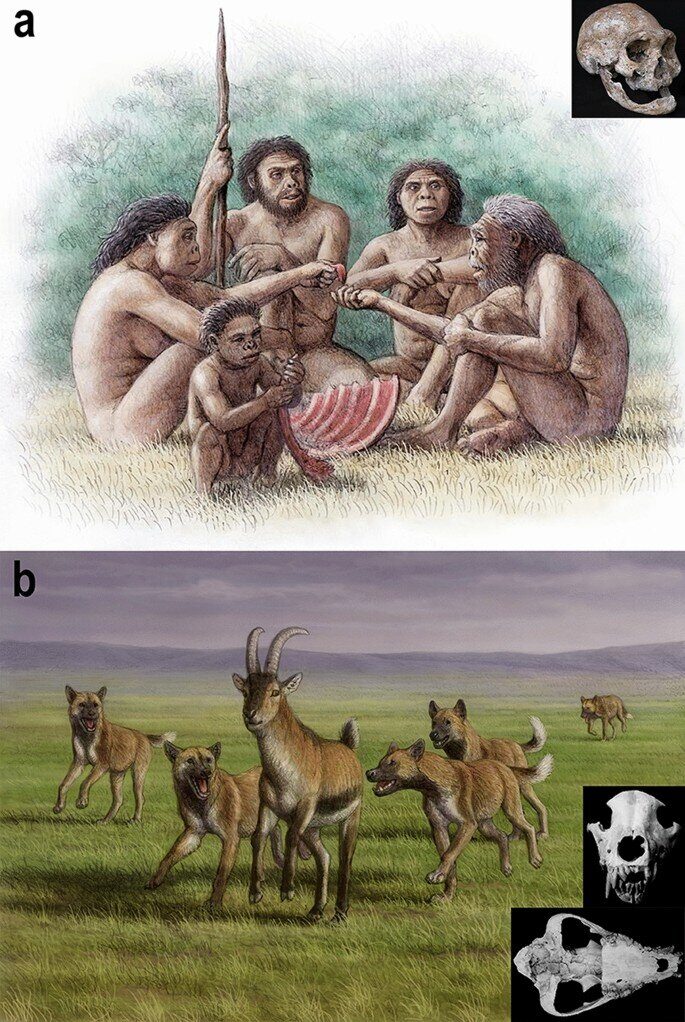
Image above: Two social species at Dmanisi. (a) altruistic behavior of a group of Homo erectus sharing food with an individual who lived several years without teeth (as evidenced by edentulous skull D3444 and associated mandible D3900). This severe masticatory impairment would limit the diet of the individual to foodstuffs that did not require heavy chewing (e.g., soft plants, animal brain and marrow) or that were orally processed before by others. (b) a pack of hunting dogs chasing a prey (goat Hemitragus albus) by at Venta Micena, a site where a pathological skull (cranium and associated mandible VM-7000) of Canis (Xenocyon) lycaonoides showing marked bilateral asymmetry and agenesia of several teeth was unearthed. The disabled dog, whose absence of an upper canine probably made it useless for hunting, is drawn running far behind the pack. Given that the individual managed to survive until a relatively advanced age, as indicated by tooth wearing, this suggests that the other members of its family group would have allowed it to feed on the prey captured by the hunting pack. Remains of this hypercarnivorous canid species are also preserved in the assemblage of large mammals from Dmanisi, as shown in this paper.A team of researchers from Italy, Spain and Georgia has found the remains of ancient hunting dogs at a dig site in what is now modern Georgia. In their paper published in the journal Scientific Reports, the group describes the fossils they found, their attempts to classify them and the possibility of the dogs interacting with early human ancestors.
Prior research has shown that a type of ancient hunting dog evolved millions of years ago in parts of Asia and then migrated into parts of Europe and Africa. Prior evidence also has shown that the dogs were quite large and likely engaged in social behaviors such as pack hunting. Prior research has also led to the discovery of the remains of ancient human ancestors near the Georgian village of Dmanisi — the oldest ever found outside of Africa. In this new study, the researchers found evidence of the hunting dogs living in the vicinity of the human ancestors at Dmanisi approximately 1.8 million years ago.
The dog remains, which included four skeletons and multiple skulls, have been classified by the team as belonging to Canis (Xenocyon) lycaonoides, commonly referred to as the Eurasian hunting dog. They have estimated that the dog likely weighed approximately 30 kg when alive and was likely quite young. They suggest it had longer limbs than modern hunting dogs and was stouter. They note that the find represents the oldest such fossil found to date in Europe and is the first to have been found at the Dmanisi site.
The researchers note that the remains do not represent domestication of the dogs. Prior research has suggested humans did not begin domesticating any kind of dog until approximately 40,000 years ago. But they note that the close proximity of the dog fossils with the human fossils suggests they did coexist and might have even stolen each other's food — modern hunting dogs have learned to eat quickly as their prey is quite often stolen by other larger animals. The find also suggests that the two species appeared to have met as the dogs were migrating south into the Middle East and Africa and the human ancestors were migrating north into Europe and Asia.
More information: Saverio Bartolini-Lucenti et al, The early hunting dog from Dmanisi with comments on the social behaviour in Canidae and hominins, Scientific Reports (2021). DOI: 10.1038/s41598-021-92818-4 Journal information: Scientific Reports



Comment: See also: